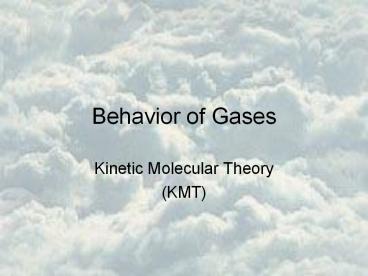Behavior of Gases - PowerPoint PPT Presentation
Title:
Behavior of Gases
Description:
Behavior of Gases Kinetic Molecular Theory (KMT) Properties of Gases 2) No definite volume: they will expand to fill their container Properties of Gases 3) Unlike ... – PowerPoint PPT presentation
Number of Views:144
Avg rating:3.0/5.0
Title: Behavior of Gases
1
Behavior of Gases
- Kinetic Molecular Theory
- (KMT)
2
Properties of Gases
- No definite shape they take on the shape of
their container
3
Properties of Gases
- 2) No definite volume they will expand to fill
their container
4
Properties of Gases
- 3) Unlike solids and liquids, they can be easily
compressed
5
Kinetic Molecular Theory (KMT)
- This theory tries to explain why gases behave
the way they do. It is model of IDEAL gas
behavior.
6
Kinetic Molecular Theory (KMT)
- Idea 1 Gases are made of particles (atoms or
molecules) that are in constant random
straight-line motion
7
Kinetic Molecular Theory (KMT)
- Idea 2 Gases particles collide with each
other and the walls of their container. - These collisions are elastic, meaning no energy
is lost during the collision, only transferred. - These collisions are measured as pressure of the
container walls
8
Elastic Collisions
9
(No Transcript)
10
Kinetic Molecular Theory (KMT)
- Idea 3 Gas particles are separated by great
distances. Therefore the volume of the
individual gas particles is negligible compared
the volume of the container.
11
Kinetic Molecular Theory (KMT)
- Idea 4 Gas particles are so far apart they do
not attract each other.
12
Pressure and number of gas particles
- More particles higher pressure
13
Temperature and volume
- Higher Temperature bigger volume (if the
container has expandable walls so that pressure
does not change) - WHY?
- Remember temp ave kinetic energy
- Higher temp means the gas particles move faster,
hitting the walls of the container harder and
pushing it outward
14
The igloo fiasco
15
(No Transcript)
16
Temperature and Volume
Volume
Temperature
17
Temperature and pressure
- Higher temperature higher pressure (if walls of
container are not exandable) - WHY?
- temp ave kinetic energy
- Higher temp means the gas particles are moving
faster, hitting the walls of the container
harder. - This results in more pressure measured on the
container walls
18
Exploding cans.
?
19
Temperature and Pressure
Pressure
Temperature
20
Pressure and Volume
- Increasing the pressure on a gas in a container
will decrease the volume
21
Pressure and Volume
Volume
Pressure































